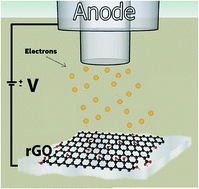Effect of the reduction process on the field emission performance of reduced graphene oxide cathodes
Abstract
The electron field emission (FE) properties of reduced graphene oxide (rGO) cathodes produced by three different reduction methods were assessed and compared. In particular, chemical reduction techniques, using either NaOH or KOH as reducing agents, were compared with thermal reduction (TR) methods. X-ray photoelectron spectroscopy (XPS) measurements revealed that different reduction techniques led to different GO lattice parameters. Furthermore, the work function measured with ultraviolet photoelectron spectroscopy (UPS) varied among the samples giving rise to different electron emission characteristics. In particular, the cathodes prepared by the TR method presented the best FE performance, showing a turn-on field of as low as ∼1.8 V μm−1 and a field enhancement factor of ∼1300, which was very close however to that shown by the NaOH-reduced sheets. The worst FE properties were exhibited by the KOH-reduced nanosheets. In light of the above results, the role of the different reduction techniques as well as the final rGO lattice characteristics with regards to the emission performance are evaluated and discussed.



 Please wait while we load your content...
Please wait while we load your content...